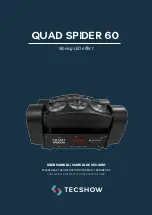
73
CHAPTER 10 – Troubleshooting
SMT-BD1/t
2 - FAULT FINDING
2.1 - System fault
If the red "SYS" LED is lit at power on, the logic board is defective.
* Check that the EPROM (firmware memory) is correctly plugged on the amplifier.
* Check that the EPROM firmware version is correct.
* Check for no conducting dust that may involve short-circuits on the amplifier logic board.
2.2 - Non stored faults
2.2.1 - BUS FAULT (PROFIBUS)
This fault is only displayed when the Profibus communication is interrupted.
The fault is cancelled as soon as the communication is restored.
2.2.2 - "UNDERVOLT." FAULT
If the fault occurs when starting the amplifier:
* Check that the power supply is on.
If the fault occurs during the operation:
* Check that the power supply connections are correct
* Check that the power supply voltage value is correct
2.3 - Stored faults
If a fault occurs on the amplifier, it can generate the detection of several other faults which are only a
consequence of the initial one. In order to make diagnostic and maintenance easier, the faults are displayed and
processed with the priority described below. For safety reasons, the power must be turned off for the cancelling of
some faults that requires the handling of the amplifier; in this case, the RESET is automatic when power is turned
on again. If power is not turned off, do not forget to make a RESET immediately after the fault is cancelled.
2.3.1 - "BUSY" FAULT
- If the BUSY fault is continuously displayed after applying power to the amplifier, the
AUTOTEST
procedure
has failed and the amplifier is not ready for operation.
- If the BUSY fault is continuously displayed after the execution of the
AUTOPHASING
function, the procedure
has failed because of an external cause and the calculated parameters are wrong. Check that the ENABLE
input is actually activated. Then check that the motor is unloaded and the shaft movement is free during the
procedure.
- If the BUSY fault is continuously displayed after the execution of the
AUTOTUNING
function, the procedure
has failed because of an external cause and the calculated parameters are wrong. Check that the
ENABLE
input is actually activated. Then check that the motor shaft movement is free during the procedure.
- If the BUSY fault is continuously displayed after the execution of the
OFFSET
function, the procedure has
failed because of an external cause and the calculated offset is wrong. Check that the
ENABLE
input is
actually desactivated. Then check that the input voltage value on the analog input 1 is less than 0.5 Volts.
2.3.2 - "EEPROM" FAULT
- Check for the presence of the EEPROM and check its correct orientation.
- If the fault remains, the EEPROM is not correctly initialised (wrong checksum value) or is not compatible with
the amplifier software.
- This fault may occur if the motor is enabled during a parameter saving or during a sequences transfer
between the PC and the amplifier.
- This fault may also occur if the cogging torque compensation has been enabled and the parameters saved in
the EEPROM without doing the cogging acquisition procedure.









































